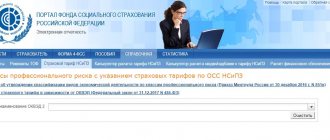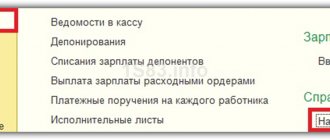The national social insurance system operating on the territory of the Russian Federation includes several components, one of which is insurance against industrial accidents, which also includes the detection of occupational diseases arising as a result of performing work duties in certain conditions. At its core, compulsory insurance of this type is an integral part of the labor relationship and is accompanied by the deduction of funds to the appropriate fund and subsequent payment upon the occurrence of an insured event, as provided by law.
Insurance against accidents and damages
Insurance against accidents and damages is a measure aimed at ensuring the protection of the insured, as well as compensation for any harm caused to the insured during the performance of his work duties. There are three parties involved in insurance against accidents and damages.
| Policyholder | Insurer | Insured |
| An organization or entrepreneur that has entered into an employment contract with at least one employee | Social Insurance Fund | Employee of an organization or entrepreneur |
Reimbursement of expenses and payments for insured events are carried out by the Social Insurance Fund, which administers contributions from the NS and PP.
Important! Tariffs for insurance premiums are calculated as a percentage of the amounts of payments under Employment contracts and GPA.
Tariffs are set by the Social Insurance Fund annually for the entire year and can vary from 0.2 percent to 8.5 percent depending on the risk class.
Essence, tasks and types
The legal basis for this type of insurance is a fairly large number of legal acts, among which the most important are Article 212 of the Labor Code of the Russian Federation and Federal Law No. 125 “On Compulsory Social Insurance”. The essence of such insurance is the constant (periodic) formation of a special reserve fund through the transfer of mandatory contributions. Possible ways to use such a contribution are those situations that, in accordance with regulatory legislation, are classified as insured events. When insured events occur, funds are transferred through the employer in an amount that is also calculated in accordance with the rules and regulations found in legal acts. In general, there are the following main tasks that insurance solves through its functioning:
- Social protection of persons who act as workers. Even in the event of the death of the insured person, those citizens who are identified as possible beneficiaries (usually close relatives) can count on the transfer of funds to them;
- The emergence of the so-called interest of employers in providing measures to reduce insurance cases related specifically to the performance of labor duties;
- Compensation for damage caused to insured persons who acted as policyholders. The law establishes the need to transfer funds as compensation for damage, as well as to cover current expenses that may be associated with injury or the detection of an occupational disease;
- Ensuring that employers and government agencies take measures aimed at reducing and preventing the occurrence of occupational diseases and injuries.
This type of insurance is divided into two main subgroups: compulsory and voluntary. Mandatory means something that will take place as a result of the conclusion of an employment contract, while voluntary can be used by the policyholder (employee) independently or on the recommendation of the employer due to certain hazards or risk factors that are present in his workplace.
Main type of economic activity
Each organization or entrepreneur carries out a certain type of economic activity.
Important! For organizations, a rule has been introduced to confirm the main type of activity annually until April 15 of the current year. For entrepreneurs, the main type of activity is taken by the fund’s specialists from the Unified State Register of Individual Entrepreneurs (USRIP) extract and does not need to be confirmed.
The main type of economic activity for legal entities is recognized as the type of activity the share of income from which exceeds 70% of the total. If a legal entity does not confirm its main type of activity, then there is a risk that the social insurance fund will assign the maximum contribution rate. But, as a rule, in such situations, the Social Insurance Fund assigns a tariff based on the main type of activity of the organization indicated in the extract from the Unified State Register of Real Estate.
Insurance premium rates
The legislation of the Russian Federation provides for the following types of compulsory insurance: compulsory pension insurance (OPS); compulsory health insurance (CHI); compulsory social insurance in case of temporary disability and in connection with maternity (OSS); compulsory social insurance against accidents at work and occupational diseases (OSS NS and PZ).
Insurance is provided by contributions to the relevant funds. The procedure for calculating and paying contributions to compulsory health insurance, compulsory health insurance, compulsory health insurance is regulated by the norms of Chapter 34 of the Tax Code of the Russian Federation. Wherein:
- contributions to compulsory pension insurance are credited to the budget of the Pension Fund for the purpose of forming pension savings for citizens of the Russian Federation (Article 3 of the Federal Law of December 15, 2001 No. 167-FZ “On Compulsory Pension Insurance in the Russian Federation”);
- contributions for compulsory medical insurance go to the Federal Health Insurance Fund and are intended to be received by insured persons in case of need of free medical care (Article 3 of the Federal Law of November 29, 2010 No. 326-FZ “On Compulsory Medical Insurance in the Russian Federation”);
- contributions to OSS go to the Social Insurance Fund in order to provide citizens with benefits in cases of disability, pregnancy and childbirth, child care (Articles 1.2, 1.4 of the Federal Law of December 29, 2006 No. 255-FZ “On compulsory social insurance in case of temporary disability and in connection with maternity").
The procedure for calculating and paying contributions to OSS NS and PZ is regulated by Federal Law No. 125-FZ of July 24, 1998 “On compulsory social insurance against industrial accidents and occupational diseases.”
Contributions to OSS NS and PZ are credited to the budget of the Social Insurance Fund of the Russian Federation and form insurance compensation for harm caused to the life or health of individuals during the performance of their work duties (Article 3 of Law No. 125-FZ).
Tariffs of insurance premiums for compulsory medical insurance, compulsory medical insurance, compulsory medical insurance are regulated by paragraph 2 of Article 425 of the Tax Code of the Russian Federation.
For 2021, the maximum base for insurance premiums for compulsory health insurance at the basic tariff has been set in the amount of RUB 1,292,000. and for OSS - 912,000 rubles. (Resolution of the Government of the Russian Federation dated November 6, 2019 No. 1407).
Tariffs and procedures for paying insurance premiums for OSS NS and PZ were established for 2006 by Federal Law dated December 22, 2005 No. 179-FZ and continue to be applied in 2021 (Federal Law dated December 27, 2019 No. 445-FZ).
For payments in favor of individuals with disabilities, 60% of the generally established insurance tariff for contributions to OSS NS and PZ is provided (Article 2 of Law No. 445-FZ, Article 2 of Law No. 179-FZ).
The size of the insurance tariff for OSS NS and PZ depends on the main type of activity of an organization or individual (including an entrepreneur) and the class of professional risk corresponding to such activity (Article 21 of Law No. 125-FZ). Moreover, for separate divisions of the organization, separated into an independent classification unit (SCU), it is possible to set a tariff that is different from the main one for the organization. The separation of non-core activities into independent classification units allows policyholders to reduce premiums for insurance against accidents and occupational diseases.
| 1C:ITS For more information about the types of contributions for compulsory insurance, tariffs and payers, see the section “Legislative Consultations”. |
Confirmation of the type of economic activity in the Social Insurance Fund
Order of the Ministry of Health and Social Development of Russia dated January 31, 2006 No. 55 determined the procedure for confirming the types of economic activities of the insured for compulsory social insurance against industrial accidents and occupational diseases. According to paragraph 9 of Order No. 55, the decision on the allocation of divisions of the insurer to SKE is made by the territorial body of the Social Insurance Fund.
The procedure for isolating SKE:
- the policyholder submits to the territorial body of the Social Insurance Fund a complete package of documents in accordance with the list established by paragraph 8 of Order No. 55;
- The territorial body of the Social Insurance Fund sends the submitted documents to the fund for approval within 7 working days;
- within 20 working days from the date of receipt of the documents, the FSS reviews them for compliance with the requirements specified in Order No. 55, and informs the territorial body of the FSS at the place of registration of the policyholder about the results;
- the territorial body of the Social Insurance Fund notifies the policyholder within two weeks of the insurance rates in force since the beginning of the current year, corresponding to the classes of professional risk, for each SKE;
- The policyholder has the right to apply tariffs corresponding to the professional risk classes for each SKE. Contributions at the appropriate rate must be calculated from the beginning of the year.
Requirements for a unit to allocate it to SKE:
- implementation by divisions of the insured of types of economic activities that are not the main type of economic activity of the insured;
- maintenance by the insured of accounting of the financial and economic activities of the insured's divisions with reflection of the corresponding income in the report in Form 4-FSS, approved. by order of the Ministry of Health and Social Development of Russia dated February 28, 2011 No. 156n;
- submission to the territorial body of the Fund within the established time frame of Form 4-FSS;
- correspondence of the names of types of economic activities indicated by the policyholder in the confirmation certificate and specified in the application for the division of the policyholder's divisions into independent classification units within the policyholder;
- absence of outstanding debts for payment of insurance premiums, penalties and fines under OSS NS and PZ.
The type of economic activity must be confirmed annually no later than April 15 (clause 3 of the Procedure, approved by Order of the Ministry of Health and Social Development of Russia dated January 31, 2006 No. 55).
The deadline for confirmation of the main type of activity for 2021 is no later than 04/15/2020. The allocation of SKE is carried out annually as part of the procedure for confirming the main type of economic activity.
The list of supporting documents that must be submitted is also given in paragraph 3 of the Procedure, approved. Order No. 55.
Please note that documents to confirm the type of economic activity can be submitted not only in paper form, but also in electronic form (clause 8 of the Procedure, approved by Order No. 55). You can generate and send to the Social Insurance Fund all the necessary documents to confirm the main type of activity of the policyholder and allocate divisions in SKE in the 1C-Reporting service.
For more information about the service, see the 1C:ITS Portal.
Occupational risk class
All types of activities are grouped into occupational risk classes; this classification is given in the Order of the Ministry of Labor dated December 30, 2016 with number 851 N. This Order establishes thirty-two groups - 32 risk classes. Each class has its own tariff. To find out what insurance rate is assigned to an organization, you can contact the Social Insurance Fund for advice.
Important! A notification with the amount of the insurance tariff is sent by the Social Insurance Fund annually to the legal address of the company.
Tariffs of insurance premiums in “1C: Salaries and personnel management 8” (rev. 3)
Tariff of insurance premiums for compulsory medical insurance, compulsory medical insurance, compulsory social insurance
The rate of insurance premiums for compulsory medical insurance, compulsory medical insurance, compulsory social insurance in the program “1C: Salaries and Personnel Management 8” edition 3 must be specified when setting up the organization’s Accounting Policy
(
Settings
-
Organizations
Accounting policy and other settings
tab -
Accounting policy
) on the
Insurance premiums
in the
Tariff type
.
The choice is made depending on the category of insurance premium payer to which the organization belongs. Follow the link History of tariff type changes...
You can view the history of changes in tariffs applied by the policyholder in different periods.
You can get acquainted with the specific rates of contributions for compulsory health insurance, compulsory medical insurance, compulsory social insurance in the card of the selected tariff (directory Insurance premium rates) on the Insurance premium rates tab (Fig. 1).
Rice. 1. Directory “Insurance premium rates”
Tariff of insurance premiums for OSS NS and PZ
In the program "1C: Salary and Personnel Management 8" edition 3, the rate of insurance premiums for OSS NS and PZ must be set when setting up the Accounting Policy of the organization (menu Settings - Organizations - tab Accounting Policy and other settings - link Accounting Policy) on the tab Insurance premiums in field Contribution rate to FSS NS and PZ (see Fig. 2).
Rice. 2. Contribution rate to the Social Insurance Fund for OSS NS and PZ
Registration of SKE
The functionality required for registration in the SKE program and calculation of contributions at the rates established for SKE is connected on the same tab. Insurance premiums with the flag. Divisions are registered in the Social Insurance Fund as independent classification units (SCU), see fig. 2.
Go to the directory Independent classification units
is possible on the tab of the same name in the
Organization
.
Independent Classification Units
card (Fig. 3) indicates
the Code according to OKVED
rev.
2 and Professional risk class
, which determine the tariff and are set on the specified date.
Rice. 3. Directory “Independent qualification units”
Within the selected contribution rate for SKE, the contribution rate may change. The contribution rate to the FSS NS and PZ is stored along with the history of its changes for the tariff.
It is possible to indicate in the program that a department is allocated to SKE only for separate departments. If the This is a separate division flag is checked in the Division card, then the Independent Classification Unit card is available for filling out and editing (Fig. 4).
Rice. 4. SKE in the card of a separate unit
Report 4-FSS
All employers are required to submit 4-FSS calculations to the Social Insurance Fund every quarter. The report is submitted on all payments to employees. The frequency of delivery of 4-FSS is every quarter. This report can be submitted both on paper (at a decent visit to the FSS or by Russian Post) or electronically via TKS. The report indicates the size of the insurance tariff, the amount of accrued contributions, and also reflects information on the payment of contributions to the Fund by month. If the organization incorrectly indicates the rate of insurance premiums in the calculation, then the Social Insurance Fund may not accept the calculation indicating inaccurate information specified in it.
Features of voluntary insurance
Unlike compulsory insurance, voluntary relationships are formalized at the personal will of the employee, that is, in this case, through the employer, the insured person provides for risks that may additionally be associated with the performance of certain job duties. In such cases, an employment contract is concluded, subsequently a voluntary insurance contract, contributions are transferred to the account of the insurer (insurance company), and only after the occurrence of an insured event the funds are paid.
At the same time, an employer can also conclude a voluntary insurance agreement. Thus, he shows the reliability of his organization, care for employees, raises the rating of the enterprise, and develops the brand. An insurance policy on average will cost the policyholder 0.5-3% of the insured amount, however, for high-risk professions (stuntman, diver, etc.), the rates will be significantly higher.







